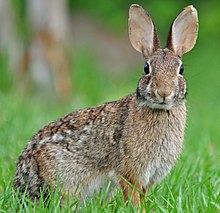Portal:Lagomorpha
Appearance
(Redirected from Portal:Rabbits and hares)
The Lagomorpha portalThe lagomorphs (/ˈlæɡəmɔːrf/) are the members of the taxonomic order Lagomorpha, of which there are two living families: the Leporidae (rabbits and hares) and the Ochotonidae (pikas). There are 110 recent species of lagomorph of which 109 are extant, including 10 genera of rabbits (42 species), 1 genus of hare (33 species) and 1 genus of pika (34 species). The name of the order is derived from the Ancient Greek lagos (λαγώς, "hare") + morphē (μορφή, "form"). (Full article...) Selected article
Rabbits and hares in art have variable mythological and artistic meanings in different cultures. The hare is often associated with moon deities and signifies rebirth and resurrection. It is a symbol of fertility and sensuality, and appears in depictions of hunting and spring scenes in the Labours of the Months. Joseph Beuys, who always found a place for a rabbit in his works, saw it as symbolizing resurrection. The Welsh sculptor Barry Flanagan was best known for his energetic bronzes of hares which he produced throughout his career. (Full article...)
Selected breed
The Netherland Dwarf is a popular breed of domestic rabbit (Oryctolagus cuniculus) originating in the Netherlands. Smaller than most rabbit breeds, Netherland Dwarf rabbits weigh 500g to 1.6kg (1.1lbs to 3.5lbs) and are usually kept as pets or exhibition animals. They are not typically used as sources of meat or fur because of their small size. Most rabbits sold in rabbit shows are Netherland Dwarfs, Netherland Dwarf-derived breeds (often referred to simply as dwarf breeds), or Netherland Dwarf crosses.
Selected quote
SubcategoriesRelated portalsSelected image Tile with two rabbits, two snakes and a tortoise. Illustration for Zakariya al-Qazwini's book, Marvels of Things Created and Miraculous Aspects of Things Existing (13th century). Abu Yahya Zakariya' ibn Muhammad al-Qazwini (1203 – 1283) was a Persian physician, astronomer, geographer and proto-science fiction writer. He travelled around in Mesopotamia and Syria, and finally entered the circle patronized by the governor of Baghdad, ‘Ata-Malik Juwayni (d. 1283 CE). This 19th-century tile from the Louvre shows two rabbits, two snakes, and a tortoise and is based on an illustration from his magnum opus Marvels of Things Created and Miraculous Aspects of Things Existing.
Selected video
Did you know"Rabbit" in…Get involvedFor editor resources and to collaborate with other editors on improving Wikipedia's Lagomorpha-related articles, see WikiProject Mammals. Things you can do
TopicsAssociated WikimediaThe following Wikimedia Foundation sister projects provide more on this subject:
|














